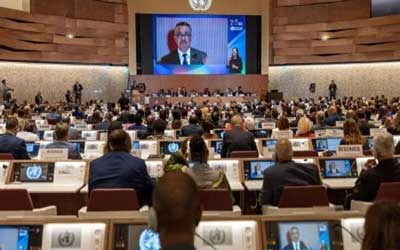Date : 26/05/2023
Relevance: GS-2: Bilateral, regional and global groupings and agreements involving India and/or affecting India’s interests, India and its neighborhood- relations.
Key Phrases: COVID, World Health Organization, U.N. Health Agency, UNGA, Pathogens, Pandemic Treaty, European Union, International Health Regulations.
Context:
- The COVID-19 pandemic has demonstrated the urgent need for stronger
global coordination and response mechanisms to effectively combat future
pandemics.
- Recognizing this, the World Health Organization (WHO) is currently engaged in negotiations to develop a new treaty aimed at bolstering the world's defenses against emerging pathogens.
The Need for a Pandemic Treaty
- The existing International Health Regulations, established in
2005, have been instrumental in managing regional epidemics but have proven
inadequate for effectively addressing a global pandemic of the scale
of COVID-19.
- To address this gap, the proposed pandemic treaty aims to create a legally binding agreement that enhances international cooperation and response mechanisms.
- Member states have recognized the importance of a legally binding treaty
for effective implementation.
- Although the United States initially expressed reservations, there is now a consensus among member states that the treaty should be binding for those who sign up.
- This commitment is crucial to ensure that countries fulfill their obligations and take swift action in the face of a future pandemic.
About WHO
- Since 1948 it has been the United Nations’ specialized health agency connecting nations, partners and communities working to promote the highest attainable standard of health for all people, regardless of race, religion, gender, political belief, economic or social condition.
- It works with 194 countries and on the front lines in 150+ locations – leading the world's response to health emergencies, preventing disease, addressing the root causes of health issues and expanding access to medicines and health care.
What is the World Health Assembly?
- The World Health Assembly is the main decision-making body of WHO and is
comprised of 194 Member States.
- Every year, generally in May, delegates from all Member States come together to agree on the Organization’s priorities and policies.
- The Seventy-sixth World Health Assembly is being held in Geneva,
Switzerland, on 21–30 May 2023.
- The theme of this year’s Health Assembly is: WHO at 75: Saving lives, driving health for all.
Addressing Concerns and Misinformation
- The proposed pandemic treaty has faced criticism, particularly on social
media platforms, with concerns raised about countries ceding authority to
the WHO.
- The WHO has vehemently refuted these claims, emphasizing that governments are leading the negotiations and maintain the freedom to reject the accord if they so choose.
- It is essential to address such concerns and debunk misinformation to build trust and ensure widespread support for the treaty.
- Member states hold varying perspectives on the proposed pandemic treaty. The European Union has emerged as a strong proponent of the accord, while developing countries, particularly in Africa, are keen to leverage the negotiations to secure improved access to vaccines.
- Negotiations have been complex, as demonstrated by the multiple areas
of disagreement and undecided language within the latest draft.
- Securing agreement among the diverse range of member countries will be a challenging task.
Complementing Existing Regulations
- An important consideration in developing the pandemic treaty is its relationship with the existing International Health Regulations.
- One potential approach is to ensure that the new rules complement the
2005 regulations, with the latter applying to local outbreaks and the former
coming into effect when the WHO declares a pandemic.
- Clarifying the interplay between these frameworks will be vital to create a comprehensive and cohesive response mechanism.
Enforcement and Compliance Measures
- Establishing enforcement and compliance mechanisms is critical to ensure
the effectiveness of the pandemic treaty.
- While it remains unclear how non-compliant states would be handled, a peer-review process has been suggested as a preferable approach over sanctions.
- This would involve a collective evaluation of countries' adherence to the treaty's provisions, providing an opportunity for dialogue, improvement, and shared learning.
Reforming Existing Regulations
- In addition to the pandemic treaty, talks are underway to reform the
2005 International Health Regulations.
- Proposed amendments aim to enhance transparency, expedite the WHO's access to outbreak sites, and improve the sharing of crucial clinical data.
- Overlapping discussions between the two reform processes have raised concerns, but efforts are being made to clarify their agendas and streamline their objectives.
Conclusion
- The development of a new pandemic treaty represents a significant opportunity for the WHO to strengthen global preparedness and response capabilities.
- By ensuring legally binding commitments, addressing concerns, and fostering international cooperation, the treaty has the potential to lay the foundation for a more effective and coordinated response to future pandemics.
- Clarifying the relationship between the new treaty and the existing International Health Regulations, along with establishing robust enforcement and compliance mechanisms, will be crucial to its success.
- As negotiations continue, it is essential to prioritize the common goal of protecting global health and collectively working towards a safer and more resilient future.
Source: The Indian Express
Mains Question:
Q. To what extent would the adoption of a legally binding pandemic treaty by the World Health Organization (WHO) effectively enhance the global response and preparedness to combat future pandemics? Analyze (250 words).







